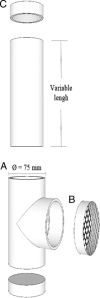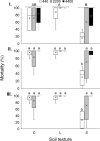Soil texture, infective juvenile concentration, and soil organic matter influence the efficacy of Steinernema feltiae isolate Lican Ray
- PMID: 32185943
- PMCID: PMC7265894
- DOI: 10.21307/jofnem-2020-007
Soil texture, infective juvenile concentration, and soil organic matter influence the efficacy of Steinernema feltiae isolate Lican Ray
Abstract
The influence of infective juveniles (IJs) concentration, soil texture, IJ-host distance and organic matter (OM) content, at different decomposition degree, on the activity of the nematode Steinernema feltiae isolate Lican Ray (LR) was examined using Galleria mellonella larvae. Bioassays were conducted in tubes of varied length, filled with soil of different textures, placed either vertically or horizontally. In the concentration assay, highest IJ concentrations caused maximum larval mortality in all soil types (440, 2,200 and 4,400 IJs in clay, loam and sandy loam). In the second assay, soil texture (loam, clay or sandy loam) interacted significantly with IJ-host distance (10, 20, 30, 40 cm, horizontally; 30, 50, 70 cm, vertically), and distances of 30 cm or more affected IJ effectiveness on the control of G. mellonella. The effect was stronger in clay and sandy loam than in loam soils, where IJ moved up to 40 cm horizontally and 70 cm vertically. In the third assay, OM content (0, 2, 4, 6 and 8%) and its decomposition degree (initial, medium and advanced) did not interact to influence IJ movement in all treatments that contained any percentage of OM (2-8%). Only in the soil with no OM, IJ did not cause death of larvae at all. These results show the potential of S. feltiae LR to be used in different soil textures, as long as the content of soil OM allows its dispersal and host infection, in order to optimize the pest-control activity of the nematode.
The influence of infective juveniles (IJs) concentration, soil texture, IJ-host distance and organic matter (OM) content, at different decomposition degree, on the activity of the nematode Steinernema feltiae isolate Lican Ray (LR) was examined using Galleria mellonella larvae. Bioassays were conducted in tubes of varied length, filled with soil of different textures, placed either vertically or horizontally. In the concentration assay, highest IJ concentrations caused maximum larval mortality in all soil types (440, 2,200 and 4,400 IJs in clay, loam and sandy loam). In the second assay, soil texture (loam, clay or sandy loam) interacted significantly with IJ-host distance (10, 20, 30, 40 cm, horizontally; 30, 50, 70 cm, vertically), and distances of 30 cm or more affected IJ effectiveness on the control of G. mellonella. The effect was stronger in clay and sandy loam than in loam soils, where IJ moved up to 40 cm horizontally and 70 cm vertically. In the third assay, OM content (0, 2, 4, 6 and 8%) and its decomposition degree (initial, medium and advanced) did not interact to influence IJ movement in all treatments that contained any percentage of OM (2–8%). Only in the soil with no OM, IJ did not cause death of larvae at all. These results show the potential of S. feltiae LR to be used in different soil textures, as long as the content of soil OM allows its dispersal and host infection, in order to optimize the pest-control activity of the nematode.
Figures






References
-
- Alekseev E., Glazer I. and Samish M.. 2006. Effect of soil texture and moisture on the activity of entomopathogenic nematodes against female Boophilus annulatus ticks. BioControl 51:507–518.
-
- Andaló V., Santos V., Moreira G. F., Moreira C., Freire M. and Moino A. Jr.. 2012. Movement of Heterorhabditis amazonensis and Steinernema arenarium in search of corn fall armyworm larvae in artificial conditions. Scientia Agricola 69:226–230.
-
- Ansari M. A. and Butt T. M.. 2011. Effect of potting media on the efficacy and dispersal of entomopathogenic nematodes for the control of black vine weevil, Otiorhynchus sulcatus (Coleoptera: Curculionidae). Biological Control 58:310–318.
-
- Bal H. K., Acosta N., Cheng Z., Grewal P. S. and Hoy C.W.. 2017. Effect of habitat and soil management on dispersal and distribution patterns of entomopathogenic nematodes. Applied Soil Ecololgy 121:48–59.
LinkOut - more resources
Full Text Sources
